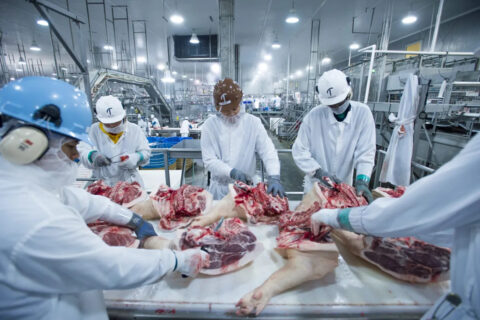Perspective
Can Men Help the Climate by Eating Less Meat?
Climate•5 min read
At some swine and poultry plants, line speeds are increasing and federal inspectors are stepping back. Industry groups support the changes, but critics warn about risks to food safety, worker health and animal welfare.


Words by Melissa Dai, Investigate Midwest
This story was originally published on Investigate Midwest.
A pig’s head arrives in front of Christopher Lopez.
He knows the drill: cut into the area behind the ears, find two small lymph nodes and incise them three or four times each. Check the nose and mouth for signs of disease — six to nine seconds to finish the inspection. Wash the gloves and sanitize the knives. One to two seconds to breathe.
Another head is already coming.
For a year and seven months, Lopez performed procedures like this for 10 hours a day, five to six days a week. It’s what he was trained for as a consumer safety inspector at the U.S. Department of Agriculture’s Food Safety and Inspection Service (FSIS).
“I would have my fingers start to lock up because I was gripping my knives too hard,” Lopez said. “Even though we kept ourselves at a high standard of being clean, I felt dirty, so I didn’t like to eat. It’s hard to stay hydrated, because if I had to take a drink, I had to take off my gloves, and I don’t have a lot of time to do that.”
At larger processing facilities, Lopez — who left his position in April — would help inspect thousands of animals a day for issues ranging from fecal matter to pathogens. The fast operation rates posed a challenge but were manageable, he said.
“I would say I had enough time,” Lopez said. “Did I have as much time as I wanted? No, absolutely not.”
Many swine and poultry plants across the U.S. are now increasing rates of processing and inspecting animals — or line speeds. The change is part of what government officials call a “modernized” inspection system, which also shifts carcass sorting duties from federal inspectors to company employees.

In March, Agriculture Secretary Brooke Rollins announced plans to extend modernization waivers and to make faster line speeds a federal standard under President Trump’s second administration.
The move could permanently change the level of oversight FSIS inspectors have on the lines.
The USDA has said increasing line speeds will help companies meet growing demand without “excessive government interference,” according to a March release. Pork and poultry industry groups backed the announcement almost immediately, and one company official told Investigate Midwest that privatizing certain responsibilities allows for more in-house accountability during inspections.

However, critics of the change argue that federal inspectors play an essential role as independent watchdogs in privately run plants, and increasing line speeds with less federal oversight poses a significant risk to consumers, workers and animals.
“To put it simply, the plant will control every aspect of it with minimal oversight,” said Paula Soldner, national joint council chairperson of a FSIS inspectors’ union.
Shifts to modernization began in 1997 as FSIS permitted faster line speeds and fewer federal inspectors at a handful of swine and poultry slaughterhouses nationwide. In 2014, a new program began permitting poultry plants to modernize voluntarily, and an opt-in system for swine plants followed in 2019.
As of August, 168 poultry plants and 18 swine establishments have converted to modernized models. Waivers for two poultry facilities and four pork plants are currently pending.

At modernized poultry plants, line speed caps have risen from 140 to 175 birds per minute, and their swine counterparts face no line speed limits. All these establishments rely on their own employees to sort carcasses — the process of analyzing meat and trimming off defects — while government inspectors remain hands-off at the ends of the lines.
Though FSIS insists the modernized system keeps federal inspectors in charge, just with fewer physical responsibilities, The Washington Post reported in 2019 that inspection duties are shifting to private companies under modernization — if not on paper, then in practice.
At Wayne-Sanderson Farms, the nation’s third-largest poultry producer with over 26,000 employees, modernization efforts have led to a handoff of inspection responsibilities, according to Juanfra DeVillena, senior vice president of quality assurance and food safety. He confirmed company personnel have taken over initial inspection tasks and are now in charge of ensuring quality, while federal inspectors continue to oversee food safety.
“FSIS is food safety inspection, and they were getting into areas that did not belong to them,” DeVillena said. “What FSIS did is they just switched their focus to what they should have always done, which is food safety, and put the quality oversight back into our operations.”
In a statement to Investigate Midwest, a USDA spokesperson maintained that modernization is backed by “science and common sense.”
“These reforms allow for greater efficiency while strengthening U.S. food production, reducing costs for producers and consumers, and supporting a more resilient supply chain,” the government spokesperson wrote.

From August 2023 to last April, Lopez worked as an inspector on and off the processing lines at 16 pork, poultry, beef or bison plants in three states. Multiple were modernized facilities, he said, including Pitman Farms, a Utah turkey establishment.
There, company personnel sorted the carcasses, and as a federal inspector, Lopez observed their actions and screened every bird at the end of the line.
There were benefits to this hands-off role, he said, like being able to “sit there and actually look at product and not have to focus on sharpening our knives.” That’s part of how FSIS framed the change in its modernization policy: by removing inspectors from hands-on duties, the agency said they could devote more time to evaluating carcasses online and completing offline verification tasks “that are more effective in ensuring food safety.”
“Extensive research has confirmed that modernized systems uphold the highest food safety standards,” the USDA spokesperson wrote to Investigate Midwest.
But under the poultry modernization program, only one federal inspector is stationed on each processing line, responsible for reviewing all carcasses sorted by plant employees. And problems arose for Lopez when the workers he oversaw consistently outnumbered him five to one.
“Yes, we’re there, and we have the potential to see everything that’s going on, but in reality, it doesn’t always work out that way,” Lopez said. “You can’t look at five people and watch everything that they’re doing as well as pay attention to what you’re inspecting.”
To Lopez, the success of a plant’s modernization depends on staffing levels. If line speeds increase, so should the number of plant workers and federal inspectors to maintain food safety standards, he said.
A USDA spokesperson did not address questions from Investigate Midwest about how the agency enforces federal staffing standards at traditional plants, and how these regulations differ at modernized plants.
Soldner, of the FSIS inspectors’ union, has visited several modernized slaughterhouses over the past few years. She said she noticed no glaring food safety concerns because all the facilities were “adequately staffed.”
But even sufficient staffing may not be enough. According to Lopez, FSIS requires its inspectors to undergo “intensive” training prior to certification, where food safety is highlighted as the top priority. At the modernized plants where Lopez worked, he said private employees tasked with carcass sorting went through similar training, though he believes it was not nearly as rigorous.
FSIS does not mandate any standardized training for company sorters. The agency instead encourages companies to conduct independent training based on federal guidelines for both pork and poultry, which are derived from FSIS inspector training protocols.
At Wayne-Sanderson Farms, DeVillena said privately-hired sorters undergo annual recertifications using an internal training manual developed from federal guidelines. The training includes classroom lectures, on-the-job training, follow-up sessions and continuous monitoring.
“I honestly don’t know the frequency in which the FSIS inspectors get trained, but I can tell you that for our group, it’s more strict because we own that process,” DeVillena said. “We gotta be able to defend it and validate it.”
But Wayne-Sanderson’s approach is not industry standard — or federally mandated. Critics say that flexibility is the problem. Without enforceable, uniform training requirements, each company can decide how thoroughly its workers are prepared to identify contamination and disease.
In public comments on the 2019 swine modernization policy, several advocacy groups urged FSIS to establish official training for company sorters. Even industry members requested that the agency improve existing training guidelines.
FSIS responded that its current guide was sufficient, and it would not be “prescribing specific sorter training or certification.” When Investigate Midwest asked why, the agency did not respond.
Adequate training only goes so far, Lopez said. In his experience, even if carcass sorters were well-trained, their priorities as private personnel may have leaned toward keeping the lines moving.
“Some of them can be sneaky about what they do,” Lopez said. In instances where he flagged a carcass for contamination but didn’t immediately take control of it, he said employees would sometimes make the contamination “mysteriously disappear” or mix the carcass in with others. “They might do it in the name of efficiency, but not necessarily in the name of food safety,” he added.
In response to Lopez’s experiences at modernized plants, DeVillena said the structure of modernized inspection systems at Wayne-Sanderson Farms makes it “impossible” to hide defects.
“Even if we wanted to do that, which we don’t want to, there’s no way for us to do that,” DeVillena said.

DeVillena described two levels of FSIS oversight at his company: a carcass inspector stationed at the end of the line to catch external contamination like fecal matter, and a verification inspector who examines 10 carcasses in detail each hour, including internal checks, to make sure company employees do their jobs effectively. He emphasized that the latter inspector can open the carcasses, examine every surface and is not directly supervising the sorters’ work — but still has full access to verify product safety.
However, other inspectors have described experiences similar to those of Lopez. In April 2020, Jill Mauer, a federal consumer safety inspector, filed a declaration as part of a 2019 lawsuit against the USDA over its swine modernization policy. In it, Mauer said she’d been working at a modernized pork plant in Austin, Minnesota, for 23 years prior.
“I have witnessed slaughterhouse employees attempt to sneak defective carcasses past me,” her declaration stated. Diseased animals and defects like “toenails, hair, and abscesses are routinely allowed for human consumption” at the facility, Mauer wrote.
Part of the problem, she said, was the short inspection time. At the modernized plant in Minnesota, “inspectors have about two seconds per pig to identify pathology and fecal contamination,” Mauer stated. Investigate Midwest reached out to her for comment, but she declined to speak on the record.
Soldner, who worked as a FSIS inspector for 32 years prior to her full-time role at the inspectors’ union, said this window wasn’t nearly enough time for federal inspectors to spot hazards — even if private employees had already reviewed the carcasses.
The shrinking role of inspectors on pork and poultry lines reflect a fundamental shift in oversight, she said.
“When I came in in 1987, we regulated the industry,” Soldner told Investigate Midwest. “Now, industry regulates what FSIS inspectors have the ability to do.”
Pork and poultry industries claim faster line speeds do not make food any less safe.
When the USDA announced its plans to formally increase line speeds in March, the National Chicken Council, a trade association representing U.S. chicken companies, voiced its support. In a March 17 release, the Council cited a 2021 study concluding that faster line speeds do not predict higher salmonella contamination risk in young chicken processing plants.
In a statement to Investigate Midwest, Tom Super, the Council’s senior vice president of public affairs, emphasized that modernization in poultry processing applies only to the speed of evisceration lines — the “highly automated” areas that involve organ removal, carcass cleaning and inspection.
“Food safety outcomes are not determined by the speed of the evisceration line,” Super wrote. Instead, he said, they depend on maintaining strict protocols, using science-backed safety measures and ensuring consistent oversight.
Investigate Midwest reached out to several other modernized swine and poultry companies for comment about faster line speeds and the reorganization of federal inspectors. None responded to multiple requests for comment.
For years, industry groups have lobbied for faster line speeds, records show.
In 2017, the National Chicken Council petitioned the government to permit faster line speeds in young chicken slaughterhouses. Shortly after, multiple trade associations and corporations shared nearly identical letters of support.
In the letters, industry groups — including the Ohio Poultry Association, the Indiana State Poultry Association, Wayne-Sanderson Farms (then Wayne Farms) and House of Raeford Farms — celebrated the petition as a step forward in “promoting and enhancing FSIS inspection procedures” and “increasing industry efficiency.”
Industry members wrote that they believe modernization would maintain food safety, citing a 2017 federal report that found no increase in salmonella contamination at modernized poultry plants.
“The data also demonstrated that inspectors are performing four times more off-line food safety verification tasks” in modernized plants than in their traditional counterparts, the letters stated.
In one letter, House of Raeford Farms — one of the top poultry producers nationwide — highlighted the “competitive disadvantage” of line speed caps. Plants in other countries like Canada operate at higher line speeds, the company wrote, so eliminating domestic line speed limits would “put U.S. producers on more equal footing.”

FSIS ultimately denied the National Chicken Council’s petition in January 2018, but said it intended to allow faster line speeds at young chicken plants that follow certain criteria “in the near future.” A month later, the agency published that criteria, permitting certain facilities to increase line speeds.
Now, under Trump’s second administration, faster line speeds are on track to become the new federal standard for both pork and poultry.
For plants with high daily outputs, Lopez, the former FSIS inspector, said that faster lines and shifting federal oversight could lead to food safety risks. But he sees potential in modernized systems, he said, especially at facilities that maintain sufficient staff and don’t overwhelm them with thousands of animals a day.
“I think that some of the medium-sized establishments really could benefit from it,” Lopez said. “The large establishments just kind of take advantage of it.”
Data shows that meatpacking and poultry companies are among the most dangerous industries in America.
Two government-commissioned studies published in January found that 81% of workers at evaluated poultry facilities and 46% of workers at evaluated swine plants were at high risk of musculoskeletal disorders (MSD) like carpal tunnel syndrome.
Many workers and advocates say faster line speeds increase risk of injury. Jose Oliva — campaigns director at HEAL Food Alliance, a coalition of food and farm system workers — called the change a “total travesty” for plant employees. Prior to HEAL, Oliva served as director of the Food Chain Workers Alliance, which represents hundreds of thousands of workers in the food system.
“Even though you are wearing protective equipment, that does not give you 100% protection,” Oliva said. “If (workers are) injured or cut themselves, if the injury is not too deep, they just continue to work. The line just keeps moving.”
A policy brief from Johns Hopkins University supports this conclusion, according to Patti Truant Anderson, the brief’s author.
“What we found in our review of literature was that there’s strong evidence that line speeds are associated with higher worker perceptions of injury risk, so they feel like it’s more unsafe when they’re made to work at these higher line speeds,” said Anderson, who is policy director at the Johns Hopkins Center for a Livable Future. Her analysis also found that line speeds are associated with “lower worker well-being and higher injury risk from repetitive tasks,” she said.
Several reports by the U.S. Government Accountability Office, a federal watchdog agency, highlight these concerns. The assessments, published between 2005 and 2017, repeatedly note stakeholder concerns about worker safety with faster line speeds. When asked if GAO is investigating modernization in light of Rollins’ recent announcement, public affairs specialist Jasmine Berry Franklin told Investigate Midwest the agency has “nothing currently in the works.”
The National Chicken Council, however, points to results from the January study on poultry workers, which suggest no associations between evisceration line speeds and MSD risk. The identical study on swine workers found conflicting evidence: faster evisceration lines were linked to an increase in MSD risk at one facility, and a decrease at another.
In the statement to Investigate Midwest, the USDA spokesperson cited the same studies, concluding “no direct link between line speeds and workplace injuries.” The agency’s March 17 announcement to formalize faster line speeds also halted any further collection of worker safety data from modernized plants, calling the information “redundant.”
According to Carisa Harris — principal investigator of both studies and director of the Northern California Center of Occupational and Environmental Health — evisceration line speeds aren’t the main determinant of worker safety.
Instead, she said, the critical metric is piece rate: the number of animal parts handled per minute by each individual worker. While evisceration line speeds measure the speed at which the lines move in one stage of processing, piece rate takes into account both line speeds and staffing levels to determine the individual workload of each employee throughout the entire process.
Both studies found a correlation between MSD risk and piece rate.
“There’s been so much attention on evisceration line speed, and our hope is that the conversation changes because that’s not the variable that’s going to help protect workers,” Harris said. “If we can talk about piece rate by area or by job, that would be a much more productive conversation to have.”
The two studies weren’t without limitations. One, as Harris called it, was “healthy worker survivor bias” — the tendency for results to reflect only workers healthy enough to continue on.
“Those who left employment due to work-related pain or the inability to keep up with the high pace of work were underrepresented,” the poultry report stated. The swine study echoed this limitation.
Debbie Berkowitz, who served as chief of staff at the Occupational Safety and Health Administration from 2009 to 2014, said she believes evaluated plants may have also added staff during the study period to reduce individual workloads while under observation.
“Because (the plants) knew they were being studied, they added workers to jobs, which meant that nobody was working harder and faster in the key jobs that they studied,” Berkowitz told Investigate Midwest.

The USDA spokesperson did not respond to a question about this phenomenon, but Harris acknowledged it was a concern — that plants may have temporarily improved working conditions during the study. However, she said her team regularly interviewed workers to assess whether the conditions they experienced during the studies matched their usual work environments. According to Harris, “very few” reported any differences.
Lori Stevermer, a Minnesota pork producer and immediate past president of the National Pork Producers Council, reiterated that “increased line speeds are not a leading factor in worker safety” in a statement to Investigate Midwest.
Super, of the National Chicken Council, said unsafe line speeds would be counterproductive for the industry itself.
“If line speeds are set too fast, then tasks will not be performed properly and the result will be a costly de-valuing of the final poultry products,” Super wrote in the statement. “No benefit exists for plant management to operate production lines at speeds that are unsafe, and will not permit all work to be performed at high levels of skill and competence.”
Slaughterhouse operations are systematic. Animals undergo a step-by-step process that stuns, scalds, removes organs, washes, cuts and chills in a highly efficient fashion.
However, protocol can go awry for a variety of reasons, ranging from worker error to machinery malfunction. And animal welfare advocates allege that it has, especially at modernized swine and poultry plants with increasing line speeds and shifting federal oversight.

Delcianna Winders, director of the Animal Law and Policy Institute at the Vermont Law and Graduate School, said that faster line speeds result in more inhumane practices.
“Animals who are not keeping pace with the line are handled violently by workers who are just trying to keep up,” Winders told Investigate Midwest. This involves “increased dragging of animals, hitting of animals and excessive electroshocking” leading up to slaughter, she said.
Concerns like these helped fuel a 2019 lawsuit filed by Winders and a group of animal welfare organizations, challenging the USDA’s swine modernization program. The lawsuit alleged, among other claims, that increasing line speeds and shifting responsibility from federal inspectors to slaughterhouse employees jeopardize humane handling.
“Even downed pigs — animals too sick or injured to walk — were handled in this way, because, according to a supervisor, they ‘don’t have time’ to handle them more humanely,” the lawsuit stated.
As part of the court case, advocates and inspectors submitted a series of declarations about personal experiences with modernization. One testimony came from Mauer, the consumer safety inspector who raised food safety concerns about her modernized pork plant in Austin, Minnesota.
Mauer wrote that on multiple occasions, she noticed pig carcasses with water-filled lungs from the scald tank — a stage in the slaughter process where animals should be dead.
“While there are a few reasons why tank water in the lungs may occur, tank water in hogs’ lungs is an indication that pigs were possibly still breathing at the time they entered the scalding tank,” her declaration stated.
Improper execution at slaughterhouses isn’t a new complaint. In 2013, the Washington Post reported that nearly 1 million birds were boiled alive in U.S. poultry plants every year, based on USDA data. This was in part due to rapid line speeds, which can result in unsuccessful slaughter prior to scald tank immersion, the article found.
But Super, of the National Chicken Council, maintained that modernization only changes the speeds of post-mortem evisceration lines. Leading up to and during slaughter, Super said, chicken processors consider animal welfare “the top priority,” and they “strictly adhere” to federal guidelines for humane handling.

Advocates remain critical. Michael Windsor — senior corporate engagement director at The Humane League, a nonprofit working to end farmed animal abuse — told Investigate Midwest in a statement that faster line speeds in any stage of processing add pressure to the entire system.
“Any increase in line speeds — pre- or post-mortem — create a dangerous ripple effect that increases suffering for animals and hazards for workers,” Windsor stated.
He added that consumers likely have a “limited sense” of what goes on behind closed doors at modernized plants.
“When people think about food safety or animal welfare, they don’t necessarily picture the exhausted workers racing to keep pace with hundreds of birds per minute or the animals being improperly stunned and boiled alive,” Windsor wrote. “This lack of awareness isn’t accidental. The meat industry operates in secrecy, and USDA policies — like allowing company employees to replace federal inspectors — only deepen the opacity.”
Four years after the 2019 lawsuit, the judge dismissed the case and upheld the federal swine modernization program. In a December 2023 ruling, the court found that FSIS had adequately considered humane handling impacts, which was all the law required.
Winders said she believes courts generally defer to the judgment of administration agencies like the USDA.
“It’s very hard to prevail against an agency because everything is going to be interpreted in their favor,” she said.
Winders and her team stand firm on one claim, arguing modernization reduces federal oversight and endangers animal welfare. They’ve appealed the ruling, and an oral argument is approaching in the next few months. With formal laws on the horizon, Winders said issues surrounding modernization are only growing more critical — not just due to risks to animals, but also to workers and consumers.
“It’s hard to disentangle the animal welfare concerns and human safety concerns,” she told Investigate Midwest. “They’re really intertwined.”
This article first appeared on Investigate Midwest and is republished here under a Creative Commons license.